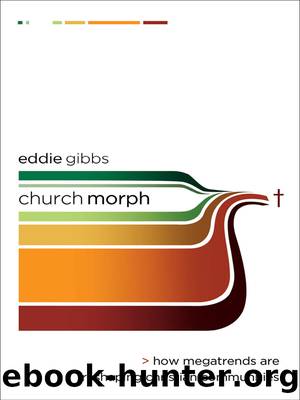ChurchMorph by Eddie Gibbs

Author:Eddie Gibbs
Language: eng
Format: epub
Tags: ebook, book
Publisher: Baker Publishing Group
Published: 2009-08-01T00:00:00+00:00
A Decentralized âClusterâ Approach
A growing number of churches are moving from a centralized approach to a more network-oriented approach involving clusters or mid-sized communities, in order to develop an ever-increasing number of neighborhood-based faith communities. These groups should not be thought of as fellowship-based home groups, nor are they independent house churches; each cluster is a full-fledged church, while at the same time relating to other clusters as part of a larger identity with shared vision and values.
Bob Hopkins describes the cluster philosophy in Clusters, a book co-authored with Mike Breen. The cluster model is designed to structure the church around the core belief that God intends people to live out their faith in communities of fellow believers within their own cultural context. Hopkins and Breen believe that the cluster concept can help unlock the clericalism, consumerism, and come-to-us mentality that have crippled the ongoing mission of the church.
To understand clusters we shall need to recognize that one of the principal weaknesses of the western church is that we have lost Biblical and sociological âcongregation.â What we now call congregation, we believe is something different. This is particularly serious because we define church as congregation and itâs the word congregation that carries all our assumptions about church.26
Churches in urban contexts can best engage the wider community by providing multiple entry points through a decentralized structure comprised of clusters. Each cluster is defined and shaped by its missional calling, which provides its distinctive ethos. The cluster concept is not simply a restructuring of a large church, which in many instances has become an alternative method of control to keep pace with numerical growth. To the contrary, clusters represent low hierarchical control with high peer accountability. The cluster is defined not by so much by its ecclesial identity as by the missional vocation that defines each one, setting them apart while also holding them together and giving them motivation.
The cluster is a mid-sized group that may or may not consist of a number of cell groups. Its size ideally is between thirty and fifty, which is small enough to provide intimacy and accountability, yet large enough to allow for a range of gifts and experience to help implement its missional vision. In other words, clusters are âsmall enough to share a common vision and large enough to do something about it.â27 The cluster is not just a gathering of neighbors, but is a grouping with a specific sociological, ecclesiological, and missional identity. Clusters also provide contexts in which new social groups can be identified and from which tailor-made clusters can emerge and grow.
Hopkins and Breen are at pains to emphasize that clusters are fully church, expressing their corporate life in three dimensions: âupwardâ in worship, which may embrace the liturgical or be entirely spontaneous; âinwardâ in discipleship, expressing hospitality, care, prayer, and financial help; and âoutwardâ in mission, listening to their chosen context to identify the needs, aspirations, and social patterns.28 They summarize the role of clusters as a place of identity,
Download
This site does not store any files on its server. We only index and link to content provided by other sites. Please contact the content providers to delete copyright contents if any and email us, we'll remove relevant links or contents immediately.
Signature in the Cell: DNA and the Evidence for Intelligent Design by Stephen C. Meyer(2879)
Real Sex by Lauren F. Winner(2869)
The Holy Spirit by Billy Graham(2779)
The Secret Power of Speaking God's Word by Joyce Meyer(2755)
The Gnostic Gospels by Pagels Elaine(2400)
Jesus by Paul Johnson(2230)
Devil, The by Almond Philip C(2207)
23:27 by H. L. Roberts(2144)
The Nativity by Geza Vermes(2117)
Chosen by God by R. C. Sproul(2057)
All Things New by John Eldredge(2052)
Angels of God: The Bible, the Church and the Heavenly Hosts by Mike Aquilina(1870)
Angels by Billy Graham(1844)
The Return of the Gods by Erich von Daniken(1842)
Knowing God by J.I. Packer(1724)
Jesus of Nazareth by Joseph Ratzinger(1710)
Evidence of the Afterlife by Jeffrey Long(1705)
The Gnostic Gospel of St. Thomas by Tau Malachi(1682)
How To Be Born Again by Billy Graham(1670)
